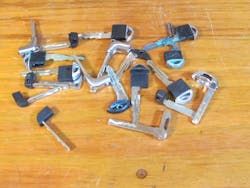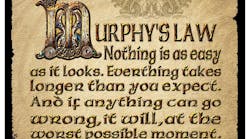I’ve heard the phrase, “good enough for government work,” so many times during my working life, that I took it for granted that it always had meant “barely good enough to get by.” But I discovered that it once had a completely different meaning.
In the 1800s, that phrase meant excellent craftmanship, something of the highest quality. Apparently, around World War II, the phrase took on its modern meaning. I once read that Harry S. Truman was so offended by the modern meaning of the phrase that he instituted many investigations into companies that supplied goods and services to the U.S. government. It was a part of his “The Buck Stops Here” approach to governing.
Regardless of when and where the phrase took on its modern meaning, we all know people who do the bare minimum to get by. We also know people who seem to take no pride in their workmanship and do the least amount of work they can get away with. In the automotive locksmithing world, these people often are referred to as “codesmiths.” If they can’t pull up a code online or from some other source, a codesmith simply walks away from the job, because they lack the skills or initiative to do the job. This leaves it for real automotive locksmiths who know how to make keys without the code to do the job properly.
Unfortunately, the “good enough for government work” crowd seem to be common at the companies that supply vehicles to many nationwide chain dealerships. Living in a relatively small town and doing work for several national chains, I unfortunately see a lot of vehicles that have been through the wholesale vehicle sales system where this attitude seems to be the rule of the day.
After a vehicle arrives at one of the dealerships that I work for, the mechanics tasked with inspecting the vehicles often discover that somewhere along the line, someone cut corners on the vehicles. If they sign off on a vehicle that doesn’t have correct keys or fobs, those vehicles will come back to haunt them.
That’s when I step in and correct the problems that someone else tried to sweep under the rug. This has become so much of my daily routine that I’m thinking about putting a sign in my truck that says “The Buck Stops Here.”
Here are a few examples of the problems regarding keys and fobs that I run into on a regular basis:
Nonfunctional Emergency Keys
We know that for most vehicles that use so-called smart keys, or proximity (prox) keys, it isn’t necessary to have a working Emergency Key (E-Key) for the vehicle to start and run. For that reason, many codesmiths who service these vehicles as they pass through the wholesale system simply don’t cut E-Keys, or they send the vehicles out with E-Keys that came from other vehicles.
When I get called in, my job is to generate a working E-Key. The mechanics might discover the problem during their inspection of the vehicle when it arrives. Or they might discover the problem when the battery has gone dead, which is a common event at many dealerships, and they can’t unlock the vehicle to open the hood. The same thing eventually would happen to whoever bought the vehicle if the problem weren’t resolved.
Now that I do mostly dealership work, I run into this problem on a regular basis. In fact, it has reached the point where I no longer assume that the E-Key in any prox actually works. Now, when I program a new prox for a vehicle at one of the dealerships, I always test the E-Key before I copy it.
Uncut E-Keys are easy to spot, but I often find an E-Key that has been cut apparently from a different vehicle. (Image 1) When I use a Lishi tool to decode the door lock, I get a working key that’s completely different from the E-Key that was supplied with the vehicle.
Unprogrammed Keys
Lately, I have been getting vehicles that have two keys or two fobs, but only one works. Sometimes, it’s because one of the fobs has failed, but often it’s because one of the fobs is from another vehicle, or it never was programed into the vehicle. Sometimes it’s something obvious, such as a Nissan that has one five-button fob and one four-button fob. Or one fob has remote start and the other doesn’t.
In those cases, it’s just a matter of figuring out which fob is correct and then programming a new fob to replace the nonworking fob. Typically, it isn’t difficult to determine which fob is correct: The correct fob works, and the incorrect fob doesn’t. But it never hurts to run the VIN to see what the vehicle actually is equipped for — the results might surprise you. Having contacts at various dealership parts departments can be a big help.
However, other times, it’s more subtle. For example, I had two Volkswagen Tiguan fobs that were identical. (Image 2) This is where a tool such as the Keytool from XHorse can come in handy. (Image 3)
On the Tiguan, one fob worked correctly, and all of the remote functions of the second fob worked, but the fob wouldn’t start the vehicle. The working fob had obvious wear on it, while the nonworking fob appeared to be brand new.
Using my Keytool Max on both fobs showed me the issue right away. When I read the chip on the older fob, it showed me that it was an MBQ chip and that it was “locked.” Locked means that the chip already had been programmed into a vehicle, and the fob now was specific to that vehicle. That was to be expected, because the fob started the vehicle.
The newer fob surprised me, however. It also was an MBQ chip, but it was “unlocked.” That meant that it either never had been programmed to a vehicle, or it had been “revirginized.” Either way, all I had to do was program the fob to the vehicle, and I was done.
I love situations like these, because I have nothing invested in the job except for my time and the use of my programmer, yet I still can charge as much as though I had supplied the fob! I have no idea how the vehicle got into that condition, but I suspect that some codesmith managed to program the remote but was unable to program an MBQ chip and decided that the result was “close enough for government work.”
Another interesting situation that I came across recently was on a 2015 Lexus CT200 hybrid. Once again, it had one working fob and one nonworking fob. Both fobs looked identical, but when I compared the part numbers, I discovered that one actually was for a Lexus GS350 made between 2008 and 2011.
I suspect that in this case, someone just mixed up two identical-looking fobs, and the nonworking fob came from a different vehicle. The fact that the E-Key in the nonworking fob had different cuts from the other E-Key, which fit the door lock, pretty much confirms that it was a mix-up. The cool thing about this one was that the Keytool Max from XHorse easily unlocks most older Lexus and Toyota prox fobs, so I sold a new prox fob, and I gained a used prox fob that I unlocked. My cost for that fob was just the cost of a replacement E-Key blank.
I have had similar situations pop up on keys, integrated remote keys and remotes. Most big dealerships are busy places. It shouldn’t be surprising that keys, fobs and remotes sometimes get mixed up. But if you do dealership work, don’t be surprised when you run across these situations. With a little thought, they give you the opportunity to be a hero and demonstrate why it’s better to use a real automotive locksmith.
That’s exactly how I got the dealership accounts that I have. Typically, I got called in to solve a problem that was too much for the codesmith in the fancy truck. By solving the problem in a quick and efficient manner at a reasonable price, I gained the respect of the service managers. Soon, they were calling me for more jobs that codesmiths were having trouble with, and, eventually, I was doing all their key work. The trick is to know what you’re doing, have the proper tools to do the job and have the wits to solve problems.
And it never hurts to hand out the occasional gift card for fast-food places or doughnut shops to the service manager or the mechanics.
Steve Young has been a locksmith since 1973 and has trained and taught locksmiths since 1988. He is a frequent contributor to Locksmith Ledger.






